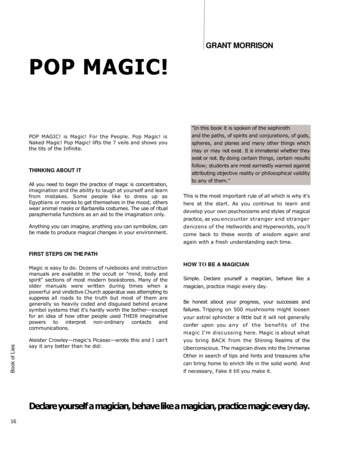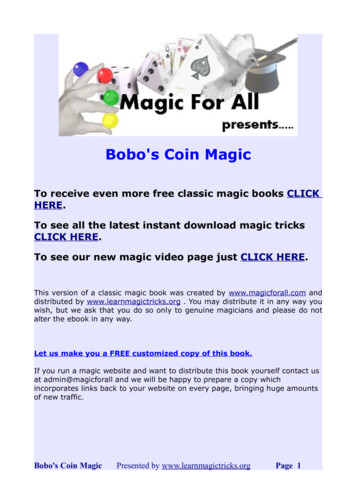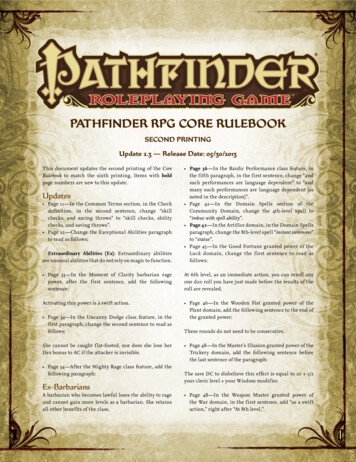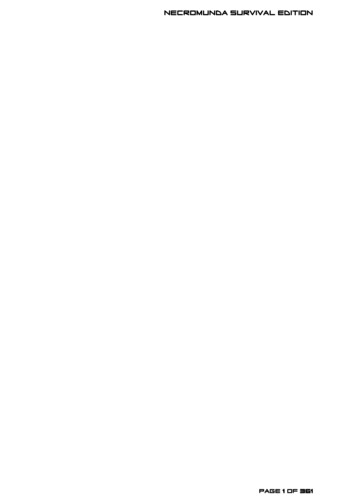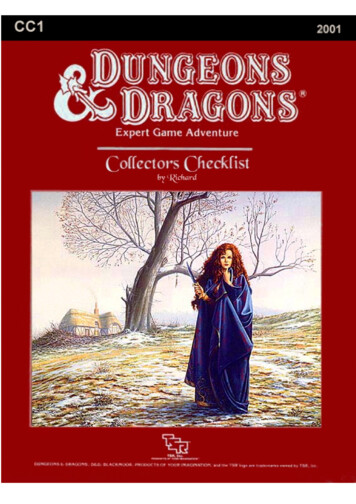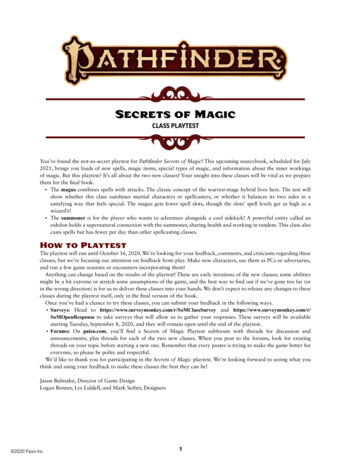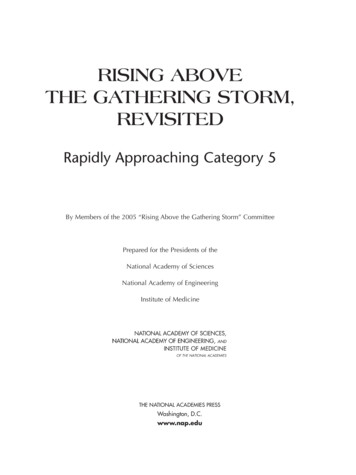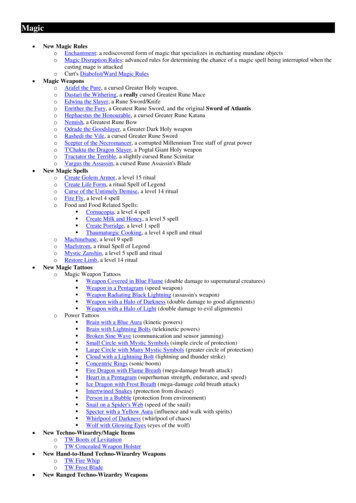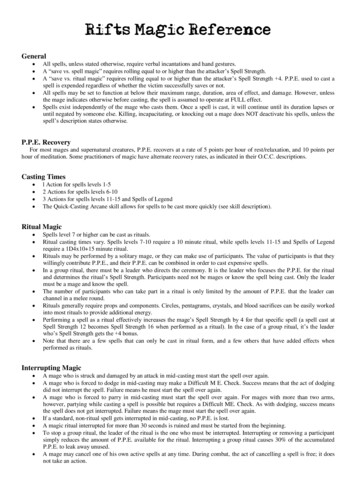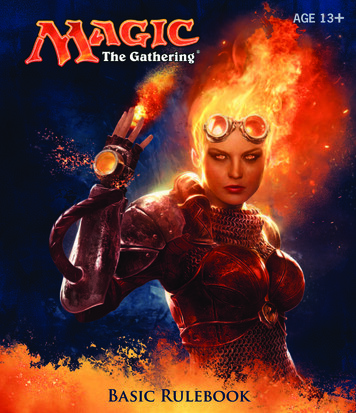
Transcription
AGE 13Basic Rulebook
Ignite Your SparkIn the Magic game, you are counted among the elite spellcasters of the Multiverse—the Planeswalkers. Some arefriends and others are foes. All wield terrifying magic and command armies of creatures torn from the endless planes ofreality. Your deck of cards represents all the weapons in your arsenal. It contains the spells you know and the creaturesyou can summon to fight for you. Customize your own Magic deck, then challenge your friends to see whose sparkburns the brightest!Trading card games likethe Magic: The Gathering game combine collectablecards with a strategy game.Start your collection withan intro pack and beginbattling immediately with aready-to-play deck.Once you’ve gotten ahandle on how to play,customize your deck usingcards from booster packs,starting with the onesincluded in your intro pack.You don’t know what cards you’ll get in a Magicbooster pack. You just start a collection and tradewith other players to get the cards you want. Youcan find stores where Magic cards are sold atWizards.com/Locator.The best part about a trading card game isthat it’s always changing. You design and buildyour own unique decks, and each Magic gameyou play is different. New Magic expansionsare released a few times a year, andeach new expansionbrings new ways tostupefy and defeat youropponents. Check outMagicTheGathering.comfor daily articles, insiderinformation, and newsabout upcoming sets!2IntroductionIllus. Brad Rigney
ContentsSection 1: The BasicsFive Colors of Mana .Parts of a Card . . . . .Card Types . . . . . . . .Game Zones . . . . . . .4558Section 2: The Building BlocksMaking Mana. . . . . . . . . .Spells . . . . . . . . . . . . . . . .Abilities . . . . . . . . . . . . . .Attacking and Blocking . .Building Your Own Deck .The Golden Rule . . . . . . . 91012131515.161616171818Section 3: Playing a GameGet a Deck . . . . . . . . . . . .Get a Friend . . . . . . . . . . .Start the Game . . . . . . . . .Parts of the Turn . . . . . . .The Next Turn . . . . . . . . .The Ever-Changing Game.Section 4: Different Ways to PlayLimited Formats . . . . . . . . . . . . . . . . . . . . . . . . . . . . . . . . . . . . . . . . . . . 19Multiplayer Variants . . . . . . . . . . . . . . . . . . . . . . . . . . . . . . . . . . . . . . . . 20Section 5: Glossary. . . . . . . . . . . . . . . . . . . . . . . . . . . . . . . . . . . . . . . . . . 21Questions? . . . . . . . . . . . . . . . . . . . . . . . . . . . . . . . . . . . . . . . . . . . . . . . . . 343Introduction
Section 1:The BasicsThe Magic: The Gathering game is a strategy game played by two or more players, each of whom has a customized deck of Magic cards.Over the course of the game, each player will take turns playing cards such as lands (which enable you to play your other cards), creatures,sorceries, and other spells. Each player starts at 20 life. When you reduce your opponent to 0 life by attacking with creatures and playingspells, you win!Five Colors of ManaOnly one thing unites the infinite planes of the Multiverse: mana, the energy that fuels all magic. The five colors of mana are imbuedin the land itself, and a Planeswalker with a connection to a place can call upon its mana from across the sea of Æther between worlds.Each color of mana fuels a different kind of powerful magic for you to command. For example, red spells have oR in their costs,and tapping (turning) a Mountain gives you oR that you can spend to cast spells. It’s up to you whether to master one color or all five.WhiteWhite is the color of law, order, andstructure. The sprawling Plains,populated by soldiers, clerics, andangels, provide white mana. You sendcoordinated armies of smaller creaturesinto battle to teach the enemy a lesson.GreenBlueGreen magic is about growth, life, andbrute force. The Forests overflow withgreen mana, which represents the pulseof nature. You empower your creatureswith the predatory might of nature anddominate through sheer size.Blue magic relies on trickery andmanipulation. Islands provide bluemana, the color of the deep sea andthe endless sky. You work behind thescenes, controlling your environmentcompletely before making a move.RedBlackRed magic erupts with fire, frenzy, andstorms of rock and lava. Red mana comesfrom Mountains and volcanoes. Youact quickly and recklessly, channelingyour wild emotions to summon mightydragons or crush the ground yourenemies walk on.Black magic is about death, disease, andpower at any cost. Black mana comesfrom dank Swamps, where things festerand rot. You are as selfish and twisted asthe undead creatures and unspeakablehorrors you command.4Section 1: The Basics
Parts of a CardMana CostCard Nameo oRoR4OOOShivan DragonType LineThis tells you the card’s card type: artifact,creature, enchantment, instant, land,planeswalker, or sorcery. If the card hasa subtype or supertype, that’s also listedhere. For example, Shivan Dragon is acreature, and its subtype is the creaturetype Dragon.Creature — DragonExpansion SymbolFlyingoR: Shivan Dragon gets 1/ 0 untilend of turn.The undisputed master of the mountainsof Shiv.Text BoxThis is where a card’s abilities appear. Youmay also find flavor text printed in italics(like this) that tells you something aboutthe Magic world. Flavor text has no effecton game play. Some abilities have italicreminder text to help explain what they do.Mana is the main resource in the game.It’s produced by lands, and you spendit to cast spells. The symbols in a card’supper right corner tell you the cost tocast that spell. If the mana cost readso4oRoR, you pay four mana of anykinds plus two red mana (from twoMountains) to cast it.5/5Donato Giancola & 2013 Wizards of the Coast 154/249This symbol tells you which Magic setthe card is from. This version of ShivanDragon is from the Magic 2014 core set.The color of the symbol tells you thecard’s rarity: black for common cards,silver for uncommons, gold for rares, andred-orange for mythic rares.Power and ToughnessCollector NumberThe collector number makes it easier to organizeyour cards. For example, “154/249” means that thecard is the 154th of 249 cards in its set.Each creature card has a special box with its power and toughness.A creature’s power (the first number) is how much damage itdeals in combat. Its toughness (the second number) is howmuch damage must be dealt to it in a single turn to destroy it. (Aplaneswalker card has a different special box with its loyalty here.)Card TypesDivinationo2oUOOEvery Magic card has one or more types. A card’s type tells you when you can play the card and whathappens to the card after you do.SorcerySorceryDraw two cards.“The key to unlocking this puzzle iswithin you.”—Doriel, mentor of Mistral IsleA sorcery represents a magical incantation. You can cast a sorcery only during a main phase of one of yourown turns. You can’t cast it when another spell is on the stack. (You’ll learn about phases and the stack in abit.) A sorcery has its effect—in other words, you follow the instructions on the card—then you put it intoyour graveyard, which is the game term for your discard pile.Howard Lyon & 2013 Wizards of the Coast 52/2495Section 1: The Basics
Doom Bladeo1oBOOInstantAn instant is just like a sorcery, except you can cast it just about any time you want, even during youropponent’s turn or in response to another spell. Like a sorcery, an instant has its effect, then you put it intoyour graveyard.InstantDestroy target nonblack creature.Chippy & 2013 Wizards of the Coast 96/249Awaken the Anciento1oRoRoROOOOEnchantmentAn enchantment represents a stable magical manifestation. An enchantment is a permanent. This means twothings: you can cast one only at the time you could cast a sorcery, and after you cast one, you’ll put it on thetable in front of you, near your lands. (Most players keep their lands closer to them, then put their othercards closer to the middle of the table.) The card is now on the battlefield. A card on the battlefield is called apermanent because it sticks around permanently (well, unless something destroys it).Some enchantments are Auras. An Aura enters the battlefield attached to a permanent and affects thatpermanent while it’s on the battlefield. If the enchanted permanent leaves the battlefield, the Aura is putinto its owner’s graveyard.Enchantment — AuraEnchant MountainEnchanted Mountain is a 7/7 red Giantcreature with haste. It’s still a land.Some days you stand to greet the horizon.Other days the horizon stands to greet you.Jaime Jones & 2013 Wizards of the Coast 126/249o5ORing of Three WishesAn artifact represents a magical relic. Like an enchantment, an artifact is a permanent, so it’ll stay on thebattlefield affecting the game. Most artifacts are colorless, so you can cast one no matter what kinds of landsyou have.Some artifacts are Equipment. You can pay to attach an Equipment to a creature you control to make thatcreature more powerful. If an equipped creature leaves the battlefield, the Equipment doesn’t—the creaturedrops it and it remains on the battlefield.CreatureArtifactRing of Three Wishes enters the battlefieldwith three wish counters on it.o5, oT, Remove a wish counter from Ringof Three Wishes: Search your library fora card and put that card into your hand.Then shuffle your library.Mark Winters & 2013 Wizards of the Coast 216/249Serra AngelArtifacto3oWoWOOOCreatures fight for you. They’re permanents, but unlike any other kind of permanent, creatures can attackand block. Each creature has power and toughness. Its power (the first number) is how much damage it dealsin combat. Its toughness (the second number) is how much damage must be dealt to it in a single turn todestroy it. Creatures attack and block during the combat phase.Unlike other types of permanents, creatures enter the battlefield with “summoning sickness”: a creaturecan’t attack, or use an ability that has oT in its cost, until it has started your turn on the battlefield underyour control. You can block with a creature or activate its other abilities no matter how long it’s been onthe battlefield.Artifact creatures are both artifacts and creatures. They’re usually colorless like other artifacts, and theycan attack and block like other creatures. An artifact creature can be affected by anything that affectsartifacts, as well as anything that affects creatures.Creature — AngelFlyingVigilance (Attacking doesn’t cause thiscreature to tap.)Follow the light. In its absence, follow her.Greg Staples4/4 & 2013 Wizards of the Coast 32/2496Section 1: The Basics
Garruk, Caller of Beastso4oGoGOOOPlaneswalker — GarrukReveal the top five cards of your library. Put all 1 : creature cards revealed this way into your hand andthe rest on the bottom of your library in any order.may put a green creature card from your hand-3 : Youonto the battlefield.You get an emblem with “Whenever you cast aspell, you may search your library for-7 : acreaturecreature card, put it onto the battlefield, thenshuffle your library.”Karl Kopinski4 & 2013 Wizards of the Coast 172/249PlaneswalkerPlaneswalkers are powerful allies you can call on to fight by your side. You can cast a planeswalker only at thetime you could cast a sorcery. They’re permanents, and each one enters the battlefield with the number ofloyalty counters indicated in its lower right corner.Each planeswalker has loyalty abilities that are activated by adding or removing loyalty counters from theplaneswalker. For example, the symbol ! means “Put one loyalty counter on this planeswalker” and the symbol3 means “Remove three loyalty counters from this planeswalker.” You can activate one of these abilities onlyat the time you could cast a sorcery and only if none of that planeswalker’s loyalty abilities have been activatedyet that turn.Your planeswalkers can be attacked by your opponent’s creatures (if so, you can block as normal), andyour opponents can damage them with their spells and abilities instead of damaging you. Any damage dealtto a planeswalker causes it to lose that many loyalty counters. If a planeswalker has no loyalty counters, it’sput into your graveyard.LandMountainBasic Land — MountainAlthough lands are permanents, they aren’t cast as spells. To play a land, just put it onto the battlefield. Thishappens immediately, so no player can do anything else in response. You can play a land only during oneof your main phases while the stack is empty. You can’t play more than one land a turn.Most lands have abilities that make mana. You’ll use lands to make the mana you need to pay for spellsand abilities.Each basic land has a mana ability that makes one mana of a particular color. Plains make white mana(oW), Islands make blue mana (oU), Swamps make black mana (oB), Mountains make red mana (oR), andForests make green mana (oG). Any land other than these five is a nonbasic land.Cliff Childs & 2013 Wizards of the Coast 242/249Card typeIs a permanentIs cast asa spellIs neswalkerInstantSorcery7Section 1: The BasicsCan attackCan be attacked
Game ZonesSince the Magic game doesn’t have a game board,zones are the areas of play that exist on your table.Here’s what a game in progress looks like. In thisexample, there aren’t any exiled cards, and no spellsare on the stack. (When you put a spell on the stack,you take the card from your hand and put it in themiddle of the table until it finishes resolving.)HANDOpponent & 2013 Wizards of the Coast 182/249Svetlin Velinov3/3“And all this time I thought we weretracking it.”—Juruk, Kalonian trackerJonas De Ro & 2013 Wizards of the Coast 248/249Basic Land — ForestAndreas Rocha & 2013 Wizards of the Coast 249/249Jung ParkForestBasic Land — ForestVolkan Baga & 2013 Wizards of the Coast 246/249Steven Belledin & 2013 Wizards of the Coast 247/249Basic Land — SwampSwamp & 2013 Wizards of the Coast 169/249 & 2013 Wizards of the Coast 182/2491/2Warren MahyBasic Land — ForestBasic Land — ForestForest & 2013 Wizards of the Coast 168/249ForestoGoGOOForestKalonian Tusker & 2013 Wizards of the Coast 240/249Creature — BeastGRAVEYARD3/3Svetlin Velinov1/1Wesley BurtEven dragons fear its silken strands.“And all this time I thought we weretracking it.”—Juruk, Kalonian trackerReach (This creature can blockcreatures with flying.)Deathtouch (Any amount of damagethis deals to a creature is enough todestroy it.)Creature — BeastCreature — Spidero1oGOOoT: Add oG to your mana pool.oGoGOOKalonian TuskeroGOElvish Mystic & 2013 Wizards of the Coast 110/249Martina PilcerovaThe dread gases didn’t kill Farbid. But ashe lay in the muck, miserable and helpless,watching ghouls and rats advance on him,he wished they had.Enchant creatureEnchanted creature gets -1/-1 for eachSwamp you control.o1oWOOAngelic WallScroll Thiefo2oUOOEnchantment — AuraCreature — Merfolk RogueCreature — Wallo2oBOOFlyingCreature spells with flying you castcost o1 less to cast.Defender (This creature can’t attack.)FlyingWhenever Scroll Thief deals combatdamage to a player, draw a card.Kapsho merfolk have infiltratedfortresses as remote as the desert citadelin Sunari in their relentless quest forarcane knowledge.“The air stirred as if fanned by angels’wings, and the enemy was turned aside.”—Tales of Ikarov the VoyagerOn Evos Isle, the swift and formidableaven enforce the will of the rulingsphinxes.2/2Nils HammQuag SicknessCreature — Bird Wizard0/4Allen Williams & 2013 Wizards of the Coast 79/2491/3Alex Horley-Orlandelli & 2013 Wizards of the Coast 4/249When you draw cards, they go to your hand, just as in most other card games.No one except you can look at the cards in your hand. You start the game withseven cards in your hand, and you have a maximum hand size of seven. (Youmay have more than seven cards in your hand, but you must discard down toseven at the end of each of your turns.) Each player has his or her own hand.Spells and abilities exist on the stack. They wait there to resolve until bothplayers choose not to cast any new spells or activate any new abilities. Then thelast spell or ability that was put onto the stack resolves, and players get a chanceto cast spells and activate abilities again. (You’ll learn more about casting spellsand activating abilities in the next section.) This zone is shared by both players.You start the game with nothing on the battlefield, but this is where the actionis going to be. On each of your turns, you can play a land from your hand.Creatures, artifacts, enchantments, and planeswalkers also enter the battlefieldafter they resolve. You can arrange your permanents however you want (werecommend putting lands closest to you), but your opponent must be able to seeall of them and tell whether they’re tapped. This zone is shared by both players.Deadly Recluse“Life grows everywhere. My kin merelyfind those places where it grows strongest.”—Nissa RevaneCreature — Elf Druido2oUOOHandBattlefieldBattlefieldWarden of Evos IsleWhen the game begins, your deck of cards becomes your library (your drawpile). It’s kept face down, and the cards stay in the order they were in at thebeginning of the game. No one can look at the cards in your library, but youcan know how many cards are in each player’s library. Each player has his orher own library.The Stack16 life leftLIBRARYLibrary & 2013 Wizards of the Coast 69/249Celestial FlareoWoWOOIslandGraveyardIslandPlainsBasic Land — PlainsInstantTarget player sacrifices an attackingor blocking creature.“You were defeated the moment youdeclared your aggression.”—Gideon JuraPlainsNils HammBasic Land — Plains & 2013 Wizards of the Coast 232/249IslandCliff ChildsBasic Land — Island & 2013 Wizards of the Coast 235/249Basic Land — IslandAndreas RochaJonas De Ro & 2013 Wizards of the Coast 231/249Basic Land — IslandClint Cearley & 2013 Wizards of the Coast 12/249 & 2013 Wizards of the Coast 237/249Noah BradleyLIBRARY & 2013 Wizards of the Coast 234/249GRAVEYARDWindreader Sphinxo1oUOOinxSphEssence ssenceCreaM140080055 MTG1 MTGM147142 M3/7ellHANDMU0Jon Foster of theWizards & 2013S-SpCoast 55/249366SphFlyinginxWhatta eneverInstantcks,ayou creature“Yomayurconspell.creaturedrawwith flyincernmindCounter targetthatfroms tothe is tooa card gpull theattempt to.bree hear thefilled with“What you spread ontoMinthe wind.”ze brin subt & 2013 YumÆther, I cangs.” le whifoolishWizardspers of—Jace BelerenthesCoast81/24918 life leftYour graveyard is your discard pile. Your instant and sorcery spells go to yourgraveyard when they resolve. Your cards go to your graveyard if an effect causesthem to be discarded, destroyed, sacrificed, or countered. Your planeswalkers goto your graveyard if they lose all their loyalty counters. Your creatures go toyour graveyard if the damage they’re dealt in a single turn is equal to or greaterthan their toughness, or if their toughness is reduced to 0 or less. Cards in yourgraveyard are always face up and anyone can look at them at any time. Eachplayer has his or her own graveyard.ExileIf a spell or ability exiles a card, that card is put in a game area that’s set apartfrom the rest of the game. The card will remain there forever, unless whateverput it there is able to bring it back. Exiled cards are normally face up. This zoneis shared by both players.8Section 1: The Basics
Section 2:The Building BlocksThis section describes the actions that you’ll take during a game. You’ll learn how to make mana, which is the resource you need to cast spells.You’ll learn how to cast a spell, as well as how to use abilities. You’ll also learn how to attack and block with your creatures. The section finisheswith a brief description of how to build your first deck and an explanation of the game’s “Golden Rule.”Making ManaTo do just about anything else in the game, you first need to beable to make mana. Think of mana as Magic money—it’s whatyou use to pay most costs. Each mana is either one of the fiveMagic colors or is colorless. When a cost requires colored mana,o for blue, Boyou’ll see colored mana symbols (oW for white, Ufor black, Ro for red, Go for green). When any kind of manacan be used to pay the cost, you’ll see a symbol with a numbero ).in it (like 2Where does mana come from? Nearly every land in the gamehas an ability that produces mana. Basic lands just have a largemana symbol in their text boxes to show this—you can tap oneof them to add one mana of that color to your mana pool. (Yourmana pool is where mana is stored until you spend it.) Otherlands, as well as some creatures, artifacts, and spells, may alsoo to your manamake mana. They’ll say something like “Add Gpool.”Mana that you’ve made doesn’t last forever. At the end of eachstep or phase of the turn, any unused mana in your mana pooldisappears. This doesn’t happen often because usually you’ll onlymake mana when you need it to cast a spell or activate an ability.PlainsPlainsBasic Land — PlainsAndreas Rocha & 2013 Wizards of the Coast 233/249Basic Land — PlainsAndreas Rocha & 2013 Wizards of the Coast 233/249Basic land typeCan be tapped forPlainsoW (white)IslandoU (blue)SwampoB (black)MountainoR (red)oG (green)ForestUntappedoWOSoulmenderTappingTo tap a card is to turn it sideways. You do this when you use a land to make mana,when you attack with a creature, or when you activate an ability that has the oTsymbol as part of its cost (oT means “tap this permanent”).When a permanent is tapped, that usually means it’s been used for the turn. Youcan’t tap it again until it’s been untapped (straightened out).At the beginning of each of your turns, you untap your tapped cards so you canuse them again.Creature — Human Cleric“Healing is more art than magic.Well,there is still quite a bit of magic.”James Ryman & 2013 Wizards of the Coast 37/249Section 2: The Building Blocks1/1oWO91/1TappedSoulmenderoT: You gain 1 life.Creature — Human ClericJames Ryman“Healing is more art than magic.Well,there is still quite a bit of magic.” & 2013 Wizards of the Coast 37/249oT: You gain 1 life.
SpellsNow that you can make mana, you’ll want to use it to cast spells. All cards except lands are cast as spells. You can cast sorceries,creatures, artifacts, enchantments, and planeswalkers only during one of your main phases when there’s nothing else on the stack.Instants can be cast at any time.Casting a SpellTo cast a spell, take the card you want to cast from your hand, showit to your opponent, and put it on the stack. (The stack is the gamezone where spells live. It’s usually in the middle of the table.)There are a few choices that you need to make right now. If thespell is an instant or sorcery and says “Choose one —,” you choosewhich of the options you’re using. If the spell is an instant or sorceryand it has a target, you choose what (or who) that target is. Aurao inspells also target the permanents they’ll enchant. If the spell has Xits cost, you choose what number X stands for. Other choices will bemade later, when the spell resolves.Now check what the spell’s cost is. Tap your lands to producethe mana necessary to pay that cost, and pay it. Once you do that,the spell has been cast.Responding to a SpellThe spell doesn’t resolve (have its effect) right away—it has to waiton the stack. Each player, including you, now gets a chance to castan instant or activate an activated ability in response. If a playerdoes, that instant or ability goes on the stack on top of what wasalready waiting there. When all players decline to do anything, thetop spell or ability on the stack will resolve.Resolving a SpellTargetPlummeto1oGOOPlummetWhen you see the word “target”on a spell or ability, you have tochoose one or more things forthe spell or ability to affect.You’ll be able to choose onlycertain kinds of things, suchas “target enchantment” or“target creature or player.”You choose the targets for aspell when you cast it, and you choose targets for anactivated ability when you activate it. If you can’t meetthe targeting requirements, you can’t cast the spell oractivate the activated ability. Once you choose targets,you can’t change your mind later.When the spell or ability resolves, it checks thetargets to make sure they’re still legal (they’re still there,and they match the requirements stated by the spell orability). If a target isn’t legal, the spell or ability can’taffect it. If none of the targets are legal, the spell orability is countered and does nothing at all.Pete Venters & 2013Wizards of the Coast188/249S-SpellCG16 M14et creaturewith flyin“Let nothg.—Dejara,ing own the skies butGiltwood druithe wind.”d129149InstantDestroy targWhen a spell resolves, one of two things happens. If the spellis an instant or sorcery, it has its effect (in other words, youfollow the instructions on the card), then you put the card intoyour graveyard. If the spell is a creature, artifact, enchantment,or planeswalker, you put the card on the table in front of you,near your lands. The card is now on the battlefield. Any of yourcards on the battlefield is called a permanent because it sticksaround permanently (well, until something happens to it). Manypermanents have abilities, which is text on them that affects thegame.After a spell or ability resolves, both players get the chance toplay something new. If no one does, the next thing waiting onthe stack will resolve (or if the stack is empty, the current part ofthe turn will end and the game will proceed to the next part). Ifeither player plays something new, it goes on top of the stack andthe process repeats.Turn the page to see examples of spells on the stack.10Section 2: The Building Blocks
Examples of Spells on the Stack1Your opponent casts Shock targeting yourAuramancer, a 2/2 creature. The Shock goeson the stack.2You respond to the Shock by casting Show ofValor on your Auramancer. Show of Valor goeson the stack, on top of Shock.3You and your opponent both decline to doanything else. Show of Valor resolves, makingthe Auramancer 4/6 until the end of the turn.421Opponent’s spellon the stackYour spell on the stack43Then the Shock resolves, dealing 2 damageto the pumped-up Auramancer. That’s notenough to destroy it.Your creature on the battlefieldWhat would happen if the Show of Valor were cast first?The Shock goes on the stack on top ofShow of Valor so it resolves first. It deals 2damage to Auramancer—enough to destroyit! When the Show of Valor tries to resolve,its only target is no longer on the battlefield,so it’s countered (it does nothing).11Section 2: The Building Blocks
AbilitiesAs you start to accumulate permanents on the battlefield, the game will change. That’s because manypermanents have text on them that affects the game. This text tells you a permanent’s abilities. Thereare three different kinds of abilities a permanent can have: static abilities, triggered abilities, and activatedabilities.Static Abilitieso1oWOOImposing SovereignCreature — HumanA static ability is text that is always true while that card is on the battlefield. For example, ImposingSovereign is a creature with the ability “Creatures your opponents control enter the battlefield tapped.”You don’t activate a static ability. It just does what it says.Creatures your opponents controlenter the battlefield tapped.Some are born to rule. The rest areborn to bow before them.Scott M. Fischer2/1 & 2013 Wizards of the Coast 22/249Triggered AbilitiesA triggered ability is text that happens when a specific event occurs in the game. For example, MessengerDrake is a creature with the ability “When Messenger Drake dies, draw a card.”Each triggered ability starts with the word “when,” “whenever,” or “at.” You don’t activate a triggeredability. It automatically triggers whenever the first part of the ability happens. The ability goes on thestack just like a spell, and resolves just like a spell. If the ability triggers but then the permanent theability came from leaves the battlefield, the ability will still resolve.You can’t choose to delay or ignore a triggered ability. However, if the ability targets something orsomeone but you can’t choose a legal target for it, the ability won’t do anything.Messenger Drakeo3oUoUOOOCreature — DrakeFlyingWhen Messenger Drake dies, drawa card.The more important the message, thelarger the messenger.Yeong-Hao Han3/3 & 2013 Wizards of the Coast 63/249Activated AbilitiesAn activated ability is an ability that you can activate whenever you want, as long as you can pay thecost. For example, Blood Bairn is a creature with the ability “Sacrifice another creature: Blood Bairngets 2/ 2 until end of turn.”Each activated ability has a cost, then a colon (“:”), then an effect. Activating one works exactly likecasting an instant spell, except there’s no card to put on the stack. The ability goes on the stack just likea spell, and resolves just like a spell. If you activate an ability but then the permanent the ability camefrom leaves the battlefield, the ability will still resolve.Some activated abilities contain the oT symbol in their costs. This means that you must tap thepermanent to activate the ability. You can’t activate the ability if the permanent is already tapped.oWo3oWOOOCreature —86905AngelFlyingcause thiscking doesn’tVigilance (Attacreature to tap.)follow her.In its absence,Follow the light.4/4s
The Magic: The Gathering game is a strategy game played by two or more players, each of whom has a customized deck of Magic cards. Over the course of the game, each player will take turns playing cards such as lands (which enable you to play your other cards), creatures, sorceries, and othe
